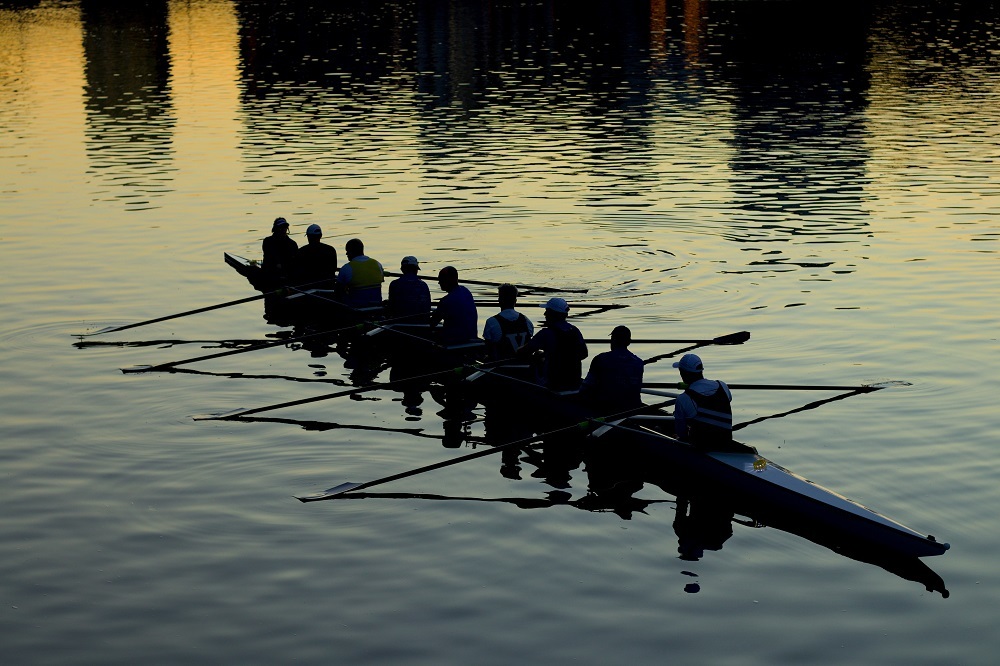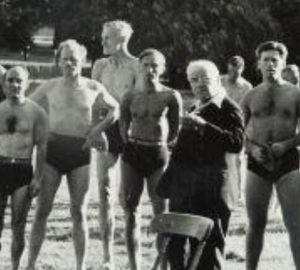Thames Swimming – Teddington Lock to Molesey Lock
The Thames is not often as clear of traffic as this
How swimmers can reduce the risk of collisions on this busy stretch of river
I had a friendly and constructive discussion on 24 March 21 with the safety officer of Kingston Rowing Club, which uses the stretch of Thames between Teddington and Molesey Locks. The growth in outdoor swimming has created additional hazards for rowers. Kingston Rowing Club is working on updating safety advice for rowers to reduce the risk of collision with a swimmer and would love to hear details from any groups who regularly swim in this stretch about when and where they swim.
From Monday 29th March, rowing clubs are allowed back on the water. He expects them to be out from 6am. Their faster, busier squads mostly row between 6am and 9am and 5pm to 7.30pm on weekdays and between 6am and noon on the weekends, but rowers and scullers can be on the water at any time of day.
Rowers would like swimmers to be aware of the following:
- Rowers and scullers find it difficult to see swimmers in the water, especially in choppy or low light conditions, or when the sun is low on the horizon and glaring off the water. Coxes of boats (often far smaller than the person sitting directly in front of them) also have limited vision of anything that is immediately in front of the boat they are steering.
- A rowing 8 weighs about a tonne and the fast crews can travels at up to 10-12 knots.
- When travelling upstream, they row on the Middlesex side. For downstream, it’s the Surrey side (i.e. on the right, based on their direction of travel).
- Where possible, they aim to be about 5-10m from the bank when heading upstream or nearest moored obstacle and will usually be a little further out from the bank (or nearest moored obstacle) when heading downstream.
- When coming through Kingston upstream, they must use the arches furthest to the right under both the road and railway bridges, where they have limited space. When travelling downstream, they can also use the middle arches.
- Rowers and scullers are encouraged to wear high visibility clothing plus a cap and sunglasses to help them see. However, they are travelling fast, backwards, and their field of vision is limited.
- If you have any concerns that they might not have seen you/are too close you should shout loudly “AHEAD SCULLER” or even just “HEAD”.
Based on the above, we recommend the following for swimmers:
- Ensure you are as visible as possible from a distance. Use a bright coloured cap and a tow float.
- Stay alert. Look up frequently and check behind you.
- Always swim with at least one other person.
- Swim close to the bank. Try to stay within 5m of it.
- If you need to cross the river, treat it like crossing a busy road. Look both ways and cross quickly. Rowing boats (and any launches supporting their crews) have no speed restriction so they will often be moving at far quicker speeds than normal powered craft.
- If you can, swim with a kayaker or stand-up paddleboarder.
- If you are swimming regularly, connect with the local rowing clubs. Ask when their peak times are and share your swimming plans.
- Pay particular attention when swimming beneath bridges. Make sure you can swim through before users reach it. Do not stop under the arches or near the bridges. Move to the side as soon as you have passed under the bridge.
Note regarding anglers
Outside of the fishing close season (15 March to 15 June), swimming close to the bank incurs the risk of entanglement with fishing lines. It is sometimes necessary to swim closer to the middle of the river to avoid these. Pay particular attention when swimming around fishing lines (in particular make sure at this point you check behind you before you change course) and move back towards the bank as soon as possible. Kingston Rowing Club will make their members aware of this issue.
KRC Navigation Map
Kingston Rowing Club have kindly shared the Navigation Map for the Teddington Lock to Molesey Lock reach which is used and followed by all rowing and skiing clubs. This shows the location of various water-sports clubs along the river, hazards and accident black spots. You will note in particular the fact that Kingston Rowing Club returns to their landing stage by turning into the upstream channel on the Surrey side of Stevens Ait. Download a copy here.

Photo by Mitchell Luo on Unsplash








